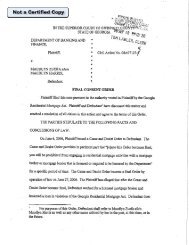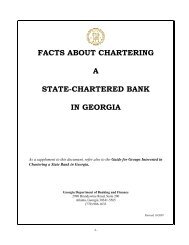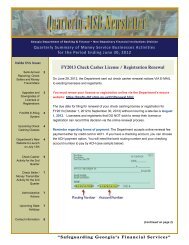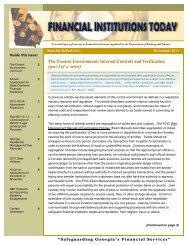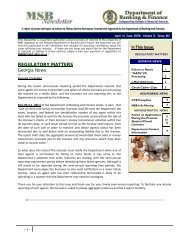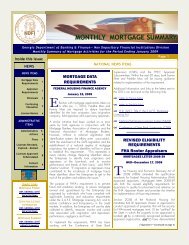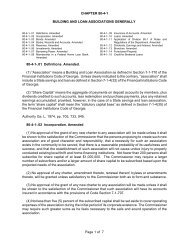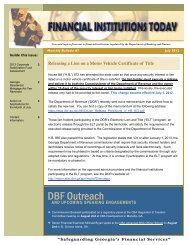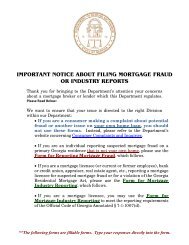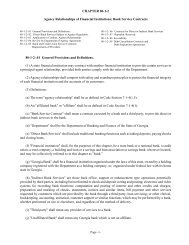OFFICIAL OPINION 2003-9 - Department of Banking and Finance
OFFICIAL OPINION 2003-9 - Department of Banking and Finance
OFFICIAL OPINION 2003-9 - Department of Banking and Finance
Create successful ePaper yourself
Turn your PDF publications into a flip-book with our unique Google optimized e-Paper software.
Therefore, a transaction that involves an extension <strong>of</strong> credit <strong>and</strong> a charge that is based on a time value <strong>of</strong> money<br />
calculation generally will fall under the usury statute unless a statutory exception exists. A charge that is not truly<br />
based on a “time value <strong>of</strong> money” calculation will not, then, be “interest,” provided that the lender is actually<br />
providing a service for which the charge is assessed <strong>and</strong> provided that the charge bears a reasonable relationship to<br />
the cost <strong>of</strong> providing the service. These provisos have their origin in decisions <strong>of</strong> the appellate courts <strong>of</strong> Georgia.<br />
The Supreme Court <strong>of</strong> Georgia “has uniformly <strong>and</strong> consistently held that a lender’s charge for service, when no<br />
service was in fact rendered or to be rendered the borrower, is a charge for the use <strong>of</strong> the money advanced <strong>and</strong> is<br />
therefore interest.” First Fed. Sav. & Loan Ass’n v. Norwood Realty Co., 212 Ga. 524, 531 (1956). See also<br />
Williams v. First Bank & Trust Co., 154 Ga. App. 879 (1980) (“service charge” constituted interest where there was<br />
no evidence that the bank performed any service in return for the fee <strong>and</strong> where one <strong>of</strong> the bank <strong>of</strong>ficers testified<br />
that he did not know what the fee was for). 2 Thus, if a particular fee is “interest” because there is no factual<br />
justification for its imposition, it must be considered cumulatively with whatever stated interest is being charged,<br />
using the controlling “time value <strong>of</strong> money” formula to determine the actual effective rate <strong>of</strong> interest. See generally<br />
<strong>2003</strong> Op. Att’y Gen. 03-8.<br />
Whether a particular overdraft protection plan involves the extension <strong>of</strong> credit <strong>and</strong> the charging <strong>of</strong> interest is a factintensive<br />
review, <strong>and</strong> each situation must be considered on a case-by-case basis. Your request describes three basic<br />
overdraft programs, each modified by the same three variations in establishing overdraft thresholds, followed by a<br />
final proviso modifying the assumptions underlying each <strong>of</strong> the foregoing overdraft program descriptions. I will<br />
address each individually with the underst<strong>and</strong>ing that these scenarios are not an exclusive list <strong>of</strong> all the possible<br />
structures <strong>of</strong> an overdraft protection plan. I turn now to the specific factual situations you have presented to me.<br />
1. An overdraft program provides that the bank may honor checks presented against an account notwithst<strong>and</strong>ing<br />
insufficient funds, provided, however, that the bank is never obligated to honor these checks <strong>and</strong> could, instead,<br />
return them unpaid. Under the program, the bank charges a flat fee per item, <strong>and</strong> this fee is the same whether a<br />
check is honored or is returned unpaid. The depositor is required by the terms <strong>of</strong> the governing deposit agreement<br />
to repay each honored overdraft <strong>and</strong> related overdraft fee immediately, without dem<strong>and</strong> or notice.<br />
Variant (a) In addition, assume that the program also provides that the bank determines whether it will pay or<br />
return the check based on an “overdraft threshold” that it establishes for each depositor <strong>and</strong> that this overdraft<br />
threshold is the same for each depositor.<br />
Variant (b) In addition, assume that the program also provides that the bank establishes a different overdraft<br />
threshold for each customer based on the customer’s monthly check volume, so that customers who routinely write<br />
large numbers <strong>of</strong> checks or large dollar amount checks have a larger overdraft limit than those customers who<br />
typically write a small number or dollar amount <strong>of</strong> checks each month.<br />
Variant (c) In addition, assume that the program also provides that the bank establishes a different overdraft<br />
threshold for each customer based on a review <strong>of</strong> that customer’s check repayment history.<br />
Assuming that the bank has a reasonable factual justification for the imposition <strong>of</strong> the fee in hypothetical 1, the fee<br />
charged under this overdraft program is not “interest” because its determination does not involve a “time value <strong>of</strong><br />
money” calculation. Likewise, <strong>and</strong> again assuming that the bank has a reasonable factual justification for the<br />
imposition <strong>of</strong> the fee, the fee charged in variants 1(a), 1(b), <strong>and</strong> 1(c) is not “interest” because its determination does<br />
not involve a “time value <strong>of</strong> money” calculation. So long as the overdraft threshold is not determined based on the<br />
amount <strong>and</strong> time value <strong>of</strong> overdraft amounts, the overdraft threshold is irrelevant to the determination <strong>of</strong> whether an<br />
overdraft fee is “interest.”<br />
2. Assume that the facts are as set forth in item 1, except that the overdraft program also provides that the bank<br />
charges a higher overdraft fee to honor the check than to return it unpaid. (Consider this program also as modified<br />
in each <strong>of</strong> the different threshold determinations described in variants (a), (b), <strong>and</strong> (c) above.)<br />
The fee charged under the assumed facts <strong>of</strong> hypothetical 2 <strong>and</strong> threshold variants 2(a), 2(b), <strong>and</strong> 2(c) does not<br />
appear to be “interest” because its determination does not involve a “time value <strong>of</strong> money” calculation. The<br />
differentiation in the level <strong>of</strong> fee would have to be reviewed more closely than the facts presented will allow, <strong>and</strong> a<br />
http://www.state.ga.us/ag/read.cgi?searchval=overdraft%20plans&openval=03-9



